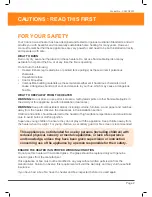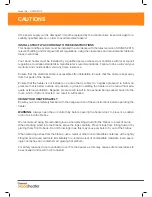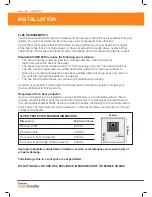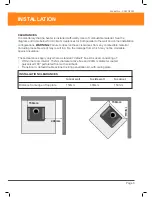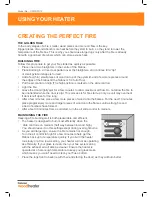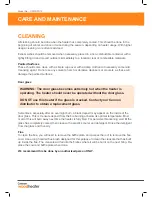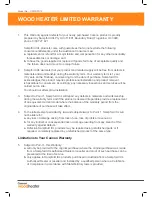
CAUTIONS
Model No – CAWDFS12
If the power supply cord is damaged, it must be replaced by the manufacturer, its service agent or a
suitably qualified person in order to avoid electrical hazard.
INSTALL STRICTLY ACCORDING TO THESE INSTRUCTIONS
This heater and flue system must be installed in accordance with the latest version of AS/NZS 2918,
relevant building and local government regulations, using the clearances and requirements tabled in
these instructions.
Your wood heater must be installed by a qualified person whose work conforms with local council
regulations, Australian standards & manufacturer’s recommendations. Failure to do so will void your
warranty and could possibly void any home insurance.
Ensure that the electrical cable is accessible after installation. Ensure that the cable is kept away
from hot parts of the heater.
Ensure that the heater is not installed in an area that is subject to “negative pressure” ie indoor air
pressure that is below outside air pressure, eg due to installing the heater in an area without ade-
quate external ventilation. Negative pressure will result in flue exhaust being sucked back into the
room, which, if left uncorrected, can result in suffocation.
USING YOUR HEATER SAFELY
Ensure you are completely familiar with the usage section of these instructions before operating the
heater.
WARNING:
Always open the air control fully before opening the heater door, to prevent a sudden
rush of air into the firebox.
We recommend using fire retardant gloves when stacking wood into the firebox to prevent burns.
When stacking wood into the firebox, place the logs carefully. Prevent logs from rolling forward by
placing them front to back. Do not throw logs in as this may cause embers to fly out of the firebox.
When removing ashes from the firebox, use a metal or other noncombustible container, with a tightly
fitting lid and moved outdoors immediately to a location clear of combustible materials. Even seem-
ingly cool ashes can contain small, glowing hot embers.
For safety reasons do not overload or over fire the heater, as this may cause safe temperatures to
be exceeded and result in a fire hazard.



